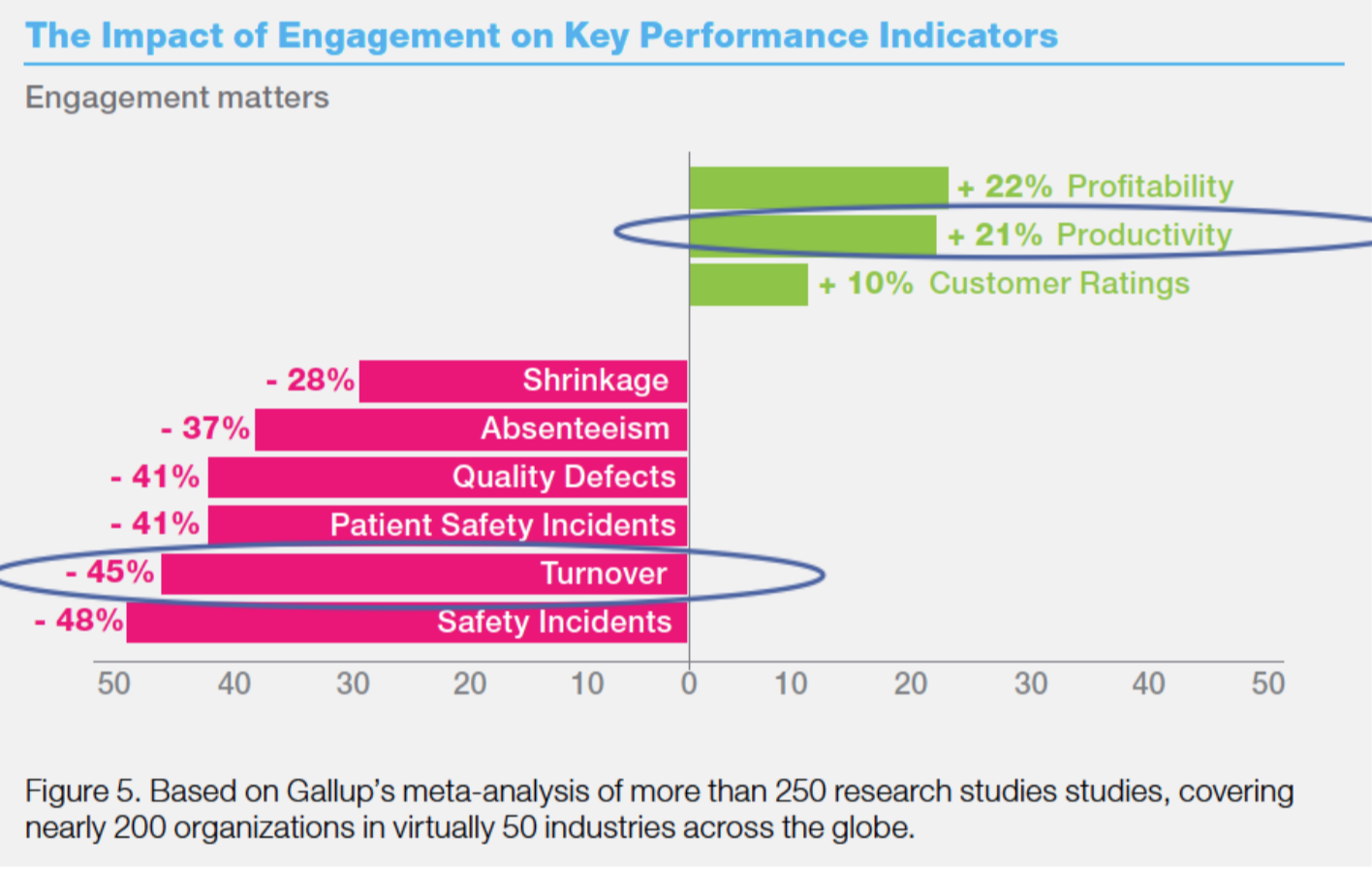How Employee Engagement Impacts Your Bottom Line


You know employee engagement matters to your workforce.
Employees who are fully committed to your organization stay longer, produce higher quality work and contribute to a more positive company culture.
If you are committed to improving in this area, you might conduct annual employee engagement surveys.
But when was the last time you sat down to quantify the impact of employee engagement in dollars and cents?
Employee Engagement By The Numbers
Employee engagement is not a single result, but a spectrum. Your company’s level of engagement may vary from time to time, but there’s always room for improvement. To measure it, Gallup divides employees into three categories:
- Engaged – Employees who are excited about the work they do and the environment in which they do it. They are emotionally invested in helping the company achieve its goals.
- Not engaged – Employees who are there for a paycheck and not much else. They are generally productive but not passionate about their role.
- Actively disengaged – Employees who are so unhappy and resentful, they actually work to sabotage the company and undermine accomplishments of their engaged coworkers.
Gallup’s most recent employee engagement data shows engagement is trending upward, but the numbers are still less than encouraging. In the average U.S. workforce:
- Only 34% of employees are engaged
- 53% of employees are not engaged
- 16.5% of employees are actively disengaged
Sometimes it’s easy to spot the employees who are actively disengaged. They turn in poor quality work and are frequently late or absent without explanation. They complain loudly to anyone who will listen. It’s much harder to identify the employees who are quietly disengaged—and unfortunately, they represent more than half your workforce!
How Employee Engagement Impacts Performance
How much of a difference does it make to have an engaged workforce?
According to a Gallup meta-analysis of research studies covering more than 200 organizations, improving employee engagement significantly improves profitability, productivity and customer service.
It also reduces negative factors, including absenteeism, quality issues, and turnover, as this graph below shows:

Imagine what your company could achieve if you could increase profitability and productivity by more than 20 percent without hiring a single person.
Calculating The Impact of Employee Engagement
Too many workplace leaders still think of employee engagement as a warm, fuzzy HR buzzword. They have a vague idea it matters, but they’re not convinced the impact is great enough to justify the investment.
That’s why if you want to make the business case for employee engagement initiatives, you’ll need some numbers to back it up.
Kate Lister, president of Global Workplace Analytics (and a recent speaker at our Big Easy Workplace Summit) has done extensive research in this area.
She has even developed a formula to calculate the financial impact of improving employee engagement.
According to the Global Workplace Analytics’ Engagement Impact Calculator™, a workplace of 1,000 employees that improves employee engagement by just 10 percent will achieve a total financial impact of more than $467,000.
This formula assumes your workplace has about 13 percent of its employees who are actively disengaged and you are able to move 10 percent of them from the lowest level of engagement to the highest.
It accounts for the amount of money saved by improving retention, as well as the anticipated increases in productivity.
Strategies to Improve Employee Engagement
Employee engagement is a multi-layered concept that requires a multifaceted strategy.
But when you think about it, a lot of it comes down to common sense.
If employees feel connected to your company’s mission, feel supported and have what they need to be comfortable and productive, they’re much more likely to be engaged.
It’s about creating a strong company culture as well as cultivating a good physical environment.
Bestselling author and speaker Jill Christensen offers several strategies for improving employee engagement:
1. Hire Slowly And Fire Quickly
Make deliberate decisions about who is in your organization and who needs to be shown the door. Strong managers and supportive colleagues create a happy, healthy environment.
2. Align Employee And Organizational Goals
Employees should know (and see) their individual work has a direct impact on the success of the organization. Each member of the workforce should be working towards a common goal that not only benefits them but also the company.
3. Build A Culture Of Two-Way Communication
To earn the trust and respect of the workforce, employers must be authentic, transparent and open. Employees must know management is being sincere and feel comfortable sharing their opinions.
4. Recognize Your Employees
Don’t let employees think their contributions don’t matter. Acknowledge how important they are to the organization and make sure they know their hard work is appreciated.
Additionally, Lister suggests making other changes that improve employee productivity and wellbeing, including:
- Implementing policies and technology that minimize interruptions in the workplace
- Implementing employee wellness programs
- Allowing flexible work arrangements whenever possible, such as giving employees the option to work remotely
- Paying attention to invisible factors like air quality and thermal comfort
- Making it easy for employees to stay connected to each other and to their workplace via a workplace app
Replacing a single employee can cost as much as 200 percent of their annual salary, depending on their role, so investing in employee engagement pays big dividends.
